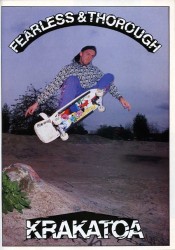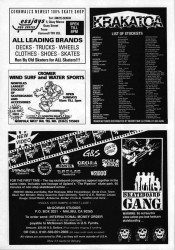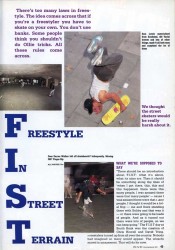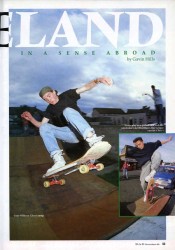 The “never play near parked cars” caption was a reference to a world in which they sometimes exploded.
The “never play near parked cars” caption was a reference to a world in which they sometimes exploded.
Captions: Never play near parked cars, and certainly don’t do Ollie Blunts like Geegee outside Clive’s
Gene Ollies at Clive’s ramp.
-
Gavin Hills on skateboarding in Ireland in 1989
 Only the double act of Vernon-and-Gavin could have handled this for us. Gavin seldom got the chance to address his bigger themes head on in R.a.d, though he was always true to them whenever he could sneak them in. There is nobody else I would have trusted to attempt this — certainly not myself. Sheryl Garratt once wrote of how she would struggle to keep Gavin from quoting William Blake in The Face; on this occasion he managed to get Yeats into R.a.D
Only the double act of Vernon-and-Gavin could have handled this for us. Gavin seldom got the chance to address his bigger themes head on in R.a.d, though he was always true to them whenever he could sneak them in. There is nobody else I would have trusted to attempt this — certainly not myself. Sheryl Garratt once wrote of how she would struggle to keep Gavin from quoting William Blake in The Face; on this occasion he managed to get Yeats into R.a.DIRELAND: IN A SENSE ABROAD
by Gavin Hills
“The innocent and the beautiful
Have no enemy but time.â€
W.B. YEATSNORTH
Someone once mentioned that everything in Ireland is a lot greener. I certainly was — me, along with the rolling hills and sheep-clad fields. To travel to Northern Ireland is to travel through history, and history in this case is a nightmare they are all trying to awake from. (more…)
-
Custom Riders, not just for Xmas
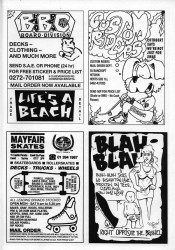 The advert that stands out for me in this lot is Custom Riders with their prophetic “we’re not just for Xmas” line. No, indeed: they’re still around 17 years later, when many others are history, like the magazine itself. But oh, what a different time that was. Simpler? More authentic? Or were we all just starting out?
The advert that stands out for me in this lot is Custom Riders with their prophetic “we’re not just for Xmas” line. No, indeed: they’re still around 17 years later, when many others are history, like the magazine itself. But oh, what a different time that was. Simpler? More authentic? Or were we all just starting out?
-
Inter-skateboard prejudice?
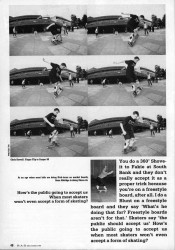 The conluding page of this story about the meeting point between freestyle and streetstyle skateboarding includes the plea: “How’s the public going to accept us when most skaters won’t even accept a form of skating?” But who wanted to be accepted in the first place? The divisions within skateboarding are just as much about establishing personal identity as the desire to identify with other skaters.
The conluding page of this story about the meeting point between freestyle and streetstyle skateboarding includes the plea: “How’s the public going to accept us when most skaters won’t even accept a form of skating?” But who wanted to be accepted in the first place? The divisions within skateboarding are just as much about establishing personal identity as the desire to identify with other skaters.You do a 360 Shove-it to Fakie at South Bank and they don’t really accept it as a proper trick because you’re on a freestyle board, after all. I do a Blunt on a freestyle board and they say ‘What’s he doing that for? Freestyle boards aren’t for that.’ Skaters say ‘the public should accept us’ How’s the public going to accept us when most skaters won’t even accept a form of skating?
-
The freestyle end of things, 1989
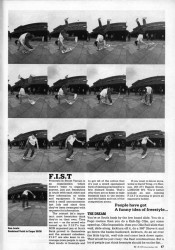 This was the freestyle aspect of F.I.S.T in evidence: the type of thing which disappeared from view over the next few years. Hands involved, not just feet. Taking in the longer perspective, from the seventies onwards, that seems to have been one of the fundamental movements in skating. Hands gradually stopped being used to hold on to boards, to drag on a bank or plant on ground or coping — but it was a very gradual move and for all I know hands are back.
This was the freestyle aspect of F.I.S.T in evidence: the type of thing which disappeared from view over the next few years. Hands involved, not just feet. Taking in the longer perspective, from the seventies onwards, that seems to have been one of the fundamental movements in skating. Hands gradually stopped being used to hold on to boards, to drag on a bank or plant on ground or coping — but it was a very gradual move and for all I know hands are back.Caption: Sam Lewis: Handstand Varial to Caspar 50/50
(more…)
-
Skate City Bromley Christmas 1989 advert
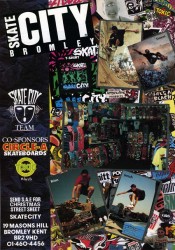 This was the Christmas issue, so advertisers splashed out on bigger-than-normal ads, or switched to colour. Bike City did both with this page which seems to have a touch of the M-Zone about it. The two shops were based relatively close to each other, on the southern fringes of London and must have been rivals to some extent.
This was the Christmas issue, so advertisers splashed out on bigger-than-normal ads, or switched to colour. Bike City did both with this page which seems to have a touch of the M-Zone about it. The two shops were based relatively close to each other, on the southern fringes of London and must have been rivals to some extent.
I liked adverts like these which featured local skaters. Can anyone now tell us more about Andy, Simon, Brian and Jonah please?
-
Freestyle In Street Terrain — skateboarding in transition
There’s too many laws in freestyle. The idea comes across that if you’re a freestyler you have to skate on your own. You don’t use banks. Some people think you shouldn’t do Ollie tricks. All these rules come across.
Captions:
Sam Lewis materialised from Southend, did Varial Inverts and lots of other things, made it all look easy and surprised the lot of themDoes Darren Walker fall off skateboards? Infrequently. Moving 360 Finger-flip
(more…)
-
When freestyle vs streetstyle seemed like an issue
 Chris Howell was a freestyler who organised events under the “F.I.S.T.” banner (Freestyle In Street Terrain). As the caption said:
Chris Howell was a freestyler who organised events under the “F.I.S.T.” banner (Freestyle In Street Terrain). As the caption said: On banks (good), Kick-flip Ollie (good), on a freestyle board (could you hold on while I take a quick attitude check on that please?)
This was a slightly uncomfortable period as people who had called themselves freestyle skaters (a very small band) suddenly saw their type of skating cross over into the mainstream, but under a different name and with a slightly different approach. Most of the photographs in the rest of the article place the emphasis on older-style freestyle, with hands involved as much as feet and wheels only to a lesser extent — but this one would fit happily with the sessions from the future.
